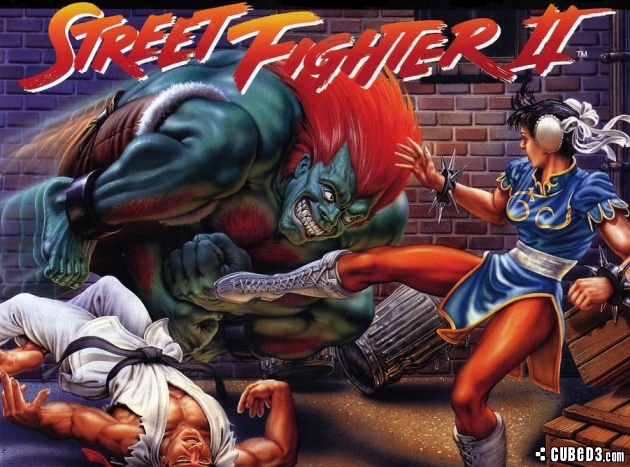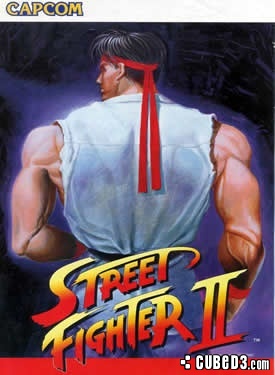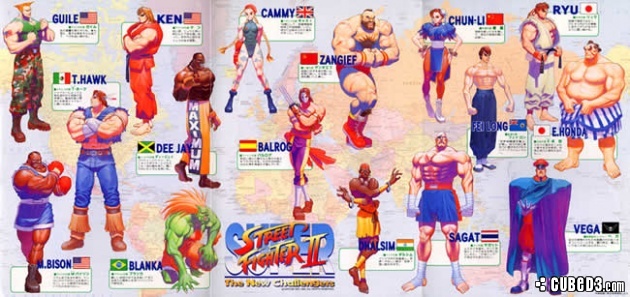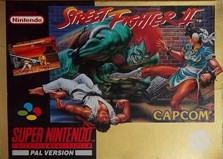
In the days of the NES, one-on-one fighting games were already pretty common. Games like Urban Champion, Yie Ar Kung fu, Karate Champ or Ring King already existed, and some of them enjoyed their moments of popularity. Other systems also received much attention in this regard in those days, but it wasn't really until Street Fighter II came along in the arcades that the genre started to rise in popularity and became as mainstream in the video game industry as RPGs or platform games.
This, as most would expect, was a sequel to the forgettable arcade game Street Fighter, also known as Fighting Street in its original home console conversion for the TurboGrafx-16, which has been available to play on the Wii Virtual Console since 2009.
Street Fighter II: The World Warrior
Street Fighter II, however, revolutionised the genre, thanks to a highly refined experience that offered controls smoother than anything previously experienced in the genre; controls that are still being copied even today! Brilliant graphics and animation made the player really capable of getting a "feel" for the game, and a button combination system was introduced - one that is very much still the basis for most side-scrolling fighting games released ever since, nonetheless! It spawned a legacy on which other studios - namely SNK - even built their popularity (although SNK did a lot to help move the genre forward in its own way, and was in turn copied back by Capcom in subsequent years).Street Fighter II was first designed for the CPS-1 arcade board system, made in-house by Capcom, and released in February 1991 in the arcades. The original hardware was obviously beyond anything available in households at the time. However, regardless of that, a port for the Super Famicom in Japan, and the SNES for those in the West, was released by Capcom in 1992.
Despite the considerably scaled back hardware of the 16-bit machine - in terms of displayable colours, screen resolution, and the data storage capacity of the SNES cartridges - the game still survived the transition pretty well. Street Fighter II, the first version of the game on Nintendo's 16-bit machine, kept most of the content intact, except for a select few moves, some voice samples and one bonus stage, but it did introduce the possibility for both players in VS mode to play as the same character if a secret code was entered, a feature that didn't appear in the arcade version until Street Fighter II Dash: Champion Edition was released.
Of course, the SNES didn't come equipped with arcade sticks by default, so most people had to make do with the emblematic D-Pad of the SNES to pull off Hadoukens and Sonic Booms. While some may argue that the only true way to play fighting games is with arcade sticks, the larger portion of the millions that bought Street Fighter II on the SNES did play it with the D-Pad, and learned how to make do with it.
 A minor complaint that could be personally levelled towards this setup, though, is that Street Fighter is a six-button game at core, and, as such, not having them neatly aligned on the face of the controller, like on the Mega Drive or PC-Engine/TurboGrafx six-button controllers, can be awkward. However, if the only true way is with an arcade stick, that doesn't make a decisive difference at the end of the day, does it?
A minor complaint that could be personally levelled towards this setup, though, is that Street Fighter is a six-button game at core, and, as such, not having them neatly aligned on the face of the controller, like on the Mega Drive or PC-Engine/TurboGrafx six-button controllers, can be awkward. However, if the only true way is with an arcade stick, that doesn't make a decisive difference at the end of the day, does it?
Street Fighter II: The World Warrior lacked some of the features of the original arcade game, but for a while, this was the only version available to play at home for most people. Being able to play the hottest arcade game of the time in the comfort of the home, even in a scaled down format, was a very big deal. Along with the likes of Super Mario Kart, it certainly helped forge the 2-player happy side of the SNES in late 1992, and early 1993. Street Fighter II was, for a lot of people, the reason they bought a SNES at the time, and this was certainly helped by a console bundle that many a SNES fan still owns today. That game alone sold 6.3 million units worldwide, making it definitely one of the best selling games on the system, and Capcom's all-time best selling game, full stop.
However, as the Arcades were seeing more updated versions of the game, namely Champion Edition and Turbo: Hyper Fighting, more ports for more consoles were produced as well, and so the SNES didn't retain it's hegemony for very long in that particular area, although the other ports didn't perform quite as well in terms of global sales.
Street Fighter II Turbo: Hyper Fighting
Then came Street Fighter II Turbo: Hyper Fighting for the SNES, which is the second Street Fighter title made available on the Wii U Virtual Console in 2013. That game was based on the Arcade game bearing almost the same name, but wasn't exclusive to the SNES anymore on the console side of things as the Mega Drive also got a port of the game. In terms of Arcade fidelity in the contents stakes, the Mega Drive version, Street Fighter II Dash: Super Champion Edition, won the contest thanks to its 24 Megabit cartridge. However, in terms of quality in the visuals and sound departments, the SNES version remains the better one overall.The SNES edition came in a 20 Megabit cartridge, which was 4 Megabits more than The World Warrior, and this showed in the content of the game. The barrel breaking bonus stage made a comeback, more voice clips could be heard from the fighters, the voice announcer was introduced to the SNES, players could directly select the same fighter in Vs mode without the need for a secret code, and characters had a slightly more varied moveset, offering a better overall balance between all the fighters available. Certain music tracks received some very minor adjustments to their sampling and instrumentation as well, which would mostly go unnoticed to the player in the thick of the action.
While these changes, with more other minor adjustments, made for a more accurate port to keep the SNES up-to-date with its arcade counterpart, these were not the main features to look out for.
The four boss characters from the original were now unlocked and made available as playable characters, bringing the playable total to twelve instead of eight. Such classic characters as Vega, Bison, Sagat and Balrog have since been made playable in pretty much all Street Fighter games. Last, but not least, was the Turbo Mode, known as Hyper Fighting in other versions, while the Normal mode was based on the Champion Edition mode from other versions. The Turbo Mode let players choose from 0 to 4 levels of turbo, represented by stars, which basically upped the speed of the gameplay. That level could be brought to ten stars if an input code was performed at the 'Turbo' logo in the intro on the second controller. The Mega Drive port made the ten stars directly selectable without the need for a code, though.
intro on the second controller. The Mega Drive port made the ten stars directly selectable without the need for a code, though.
Street Fighter II Turbo may not have been quite as commercially successful as its predecessor on the SNES, perhaps due to the fact that the game was made directly available on the Mega Drive - its biggest competitor - at the same time... Or maybe it was due to the game looking perhaps a bit too close to the original in terms of content, making potential buyers perhaps more hesitant to pay for what was, at its core, essentially a very similar game. That one still sold 4.1 million copies on the SNES alone, though, which even by nowadays standards is still a very good commercial performance, especially given the smaller install bases of consoles back then. For the sake of completion, there was also a Game Boy Advance remake, entitled Super Street Fighter II: Turbo Revival that Cubed3 reviewed almost a decade ago!
Super Street Fighter II: The New Challengers
Moving along, the arcades got yet more newly updated versions of Street Fighter II. The next big step was Super Street Fighter II: The New Challengers, which as some may know, also got ported to the SNES and Mega Drive. The SNES version is the third and final one made available on the Wii U Virtual Console in 2013, although both that one and the Mega Drive versions were additionally available on the Wii Virtual Console long before.In the arcades, Super Street Fighter II was an important step forward as it was the first to move up to the CPS-II arcade hardware, offering improved audio and graphics. While the change in terms of graphics didn't really translate in any noticeable form to the home ports of the time, the change to a sample-based audio system meant that the music could be ported quite well to the SNES, which also had a sample-based sound chip, the SPC700. In comparison, the FM Synth-based sound chip of the Genesis / Mega Drive couldn't handle the in-game music and voice samples quite as well, despite the 40 Megabit cartridge - rather than the more humble 32 Megabits on the SNES - although the announcer did introduce the round numbers on the Mega Drive, yet not on the SNES, for some reason...
All in all, the game still played very much the same. A few new moves were introduced to some of the original characters, while character clones such as Ken and Ryu were now better differentiated from one another by different animations, as well as different visual effects and voice clips. The announcer was now a totally different voice, too.
More original play modes were introduced as well, like Group Battle and Tournament Battle, which offered more options for two players to fight against one another, while Time Battle offered a bigger challenge to avid solo players. The Mega Drive version had, in addition to those, a Score Challenge and the ability to play through the Super Battle solo game in Expert Mode, which let gamers fight all 16 characters in a row instead of just 12.
Additionally, a Turbo Mode was present, although nowhere near as fast as Street Fighter II Turbo could be when at the full 10 stars speed. The SNES version of Super Street Fighter II let players crank up the speed to three stars by pressing "right" on the D-Pad at the game start screen. The Mega Drive version, on the other hand, allowed for it to be cranked up one more from the start.
Other than an additional star for the speed, two extra play modes and a couple of extra voice samples, and at least one more music track (in the options menu) - the Mega Drive version was still almost identical, although most would agree that it looked and sounded worse than the SNES version due to the FM Synthesis chip not being well suited for reproducing the samples of the arcade (or not exploited very well by the programmers...). The Mega Drive version was uncensored though, as in the SNES iteration blood would appear white - like sweat - on the tumefied faces of the defeated fighters on their character portraits after battles. Also, the Vs. logo between fights appeared on a purple puddle of blood in the SNES version instead of the red of the Mega Drive edition.

At the end of the day, Super Street Fighter II was, as to be expected, the better of the bunch. Indeed, as its subtitle implies, there were now new challengers to play as. Cammy, Fei Long, T. Hawk and Dee Jay completed the cast of characters and brought it to a total of 16. Not only that, but characters now all had very distinctive voices and even cooler poses. The music was also a greater step forward compared to how similar it sounded between the first two SNES ports. The game also counted bonuses for making combos, something that has now become a staple of most fighting games.
The many game modes made it a better experience, especially on the multiplayer side of things, making it the most desirable of the three to get for the Wii U today, especially as they all come at the same price. However, should Wii U owners get any Virtual Console version other than this one? Well, Turbo offers the fastest paced action of three, so if really unable to live without the fastest turbo mode of that particular version, then perhaps may want to get that one instead or in addition to Super Street Fighter II. The original, however, can hardly be recommended unless people really must own all of them. Cleverly enough, Nintendo made a promo that lasted until 29th August, 2013 whereby if anyone bought one of the three, another or both of the others could be bought at 50% off the original price. Now, though, with the sale over, everything has changed.
Are any of the other versions going to be made available at long last? Namely the TurboGrafx-16 Champion Edition, or any of the Mega Drive ports? That remains unknown for now. Or even better yet, the Street Fighter Alpha 2 SNES port that, despite its load times, was quite an excellent late SNES game? Capcom has yet to make any announcement in that regard, but Cubed3 will make sure to let readers know if it is.

 Sign In
Sign In 24.12.2013
24.12.2013  Game Details
Game Details
 Out now
Out now  Out now
Out now  Out now
Out now  Out now
Out now  jesusraz
jesusraz 
 Link to this post:
Link to this post:  Crapcom you hate wii u & you know it! >=( one more thing crapcom, people asked for street fighter 4 on nintendo HOME consoles (wii-u) NOT the 3ds! >=(
Crapcom you hate wii u & you know it! >=( one more thing crapcom, people asked for street fighter 4 on nintendo HOME consoles (wii-u) NOT the 3ds! >=( Subscribe to this topic
Subscribe to this topic Features
Features





 Top
Top

